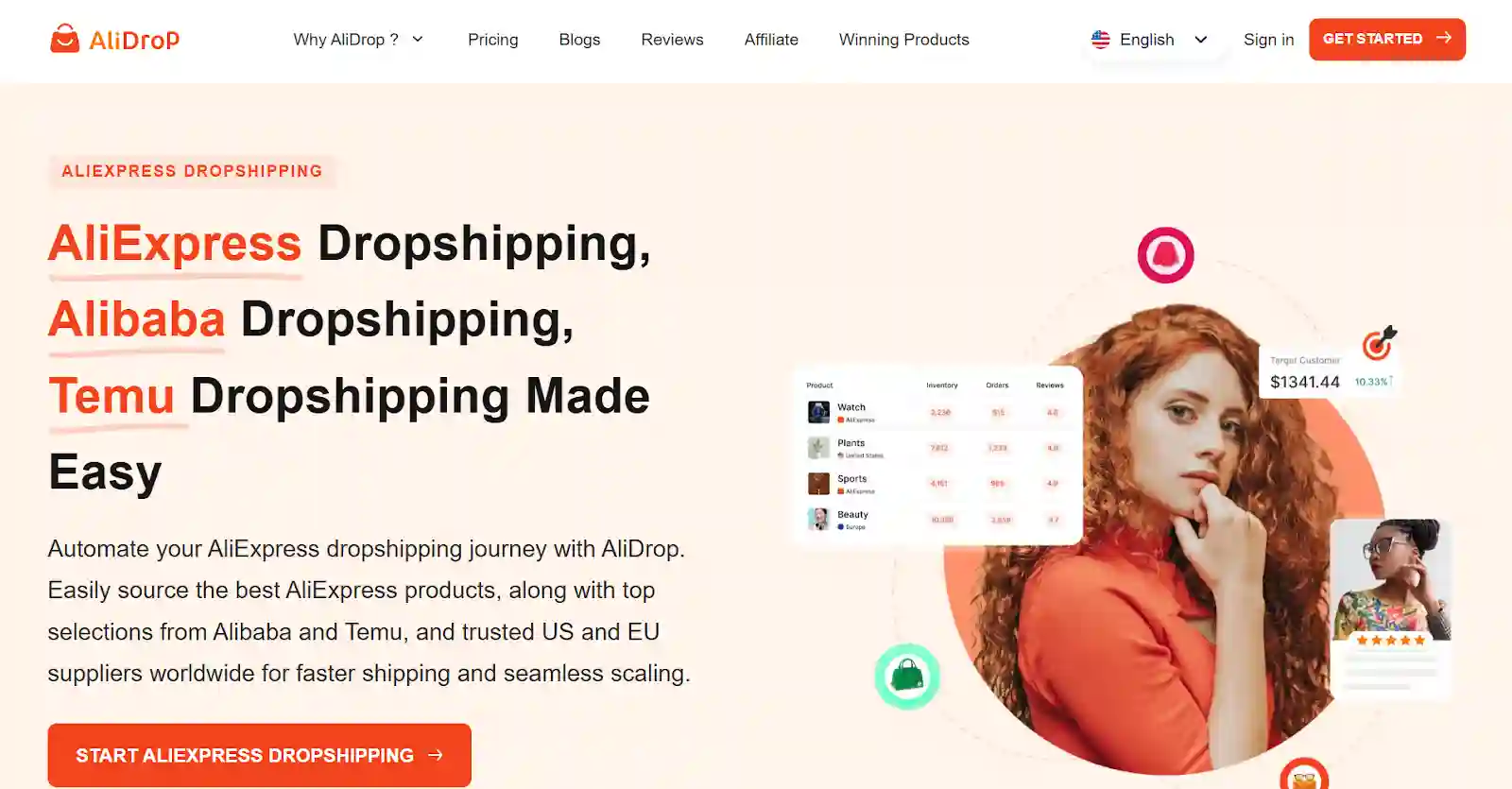Delivery times matter when you run an online store. No one likes waiting weeks for a parcel, and that’s where a five-to-seven day delivery promise comes in. You may think only big chains can achieve that, but even small drop shippers can reach those time frames with the right tools. Shipping can make or break an order.

Fast shipping is a key selling point in a crowded marketplace. It helps build trust. In this blog we’ll talk about how to manage quick shipping and smart product sourcing using AliDrop. Grab a coffee and let’s walk through some practical steps together.
What Does 5–7 Day Delivery Really Mean?
Many shoppers expect their orders to arrive in a week or less. Five to seven days might seem generous when compared to same‑day or next‑day promises, but for cross‑border orders it’s still ambitious. When we talk about a five‑to‑seven day window, we’re counting working days from the moment the parcel leaves the warehouse to the time it hits your customer’s doorstep. This doesn’t include order processing or weekends. You need to factor in weekends, public holidays, and any customs hold‑ups if you’re shipping abroad. The aim is to keep the gap small, letting buyers feel confident that their new gadget or outfit will arrive before they’ve forgotten about it.
This timing is crucial because long waits often lead to abandoned carts. Fast shipping builds trust and encourages repeat purchases. From a business point of view, quicker deliveries reduce customer service queries and refunds. When clients know exactly when their item will arrive, they won’t hound you with ‘where is my order?’ emails. Keeping your promises on time also boosts your store’s reputation, leading to better word‑of‑mouth referrals and higher search engine rankings.
Why Fast Shipping Matters for Dropshipping?
If you notice a high number of abandoned checkouts, slow delivery could be the culprit. In dropshipping you’re often reliant on suppliers to ship orders on your behalf. Standard AliExpress shipping can take two weeks or more, which turns away impatient shoppers. Shortening delivery to within a week makes a big difference in customer satisfaction. When someone buys a phone case or a pair of trainers, they’re excited. Waiting three weeks can deflate that excitement. By offering a quicker timeline, you maintain that anticipation.
Faster shipping also means you don’t tie up your cash in refunds and chargebacks. A buyer who doesn’t receive an order on time might cancel their payment or open a dispute. Losing both the sale and the time you spent on customer service hurts. With a streamlined supply chain and realistic delivery estimates, you keep more money in your business. Quick deliveries can also improve your search rankings because search engines see low bounce rates and positive reviews as signs of quality. That’s why five‑to‑seven day shipping is worth pursuing.
Alidrop integrates with AliExpress, Alibaba, and Temu. It automates product sourcing and order fulfilment, and it links to major platforms so you can ship from warehouses near your customers. This integration makes it easier to meet fast shipping promises because you can choose suppliers with warehouses in the US or EU. Those regional warehouses cut transit times compared to shipping from China.
How to Choose Suppliers for Fast Shipping?
Your choice of supplier is the largest factor in shipping times. Not all AliExpress or Alibaba sellers have warehouses outside China. Look for suppliers that carry inventory in the US or EU because deliveries from those warehouses tend to arrive within a week. On AliDrop’s platform you can filter products by warehouse location, letting you select items that are stored near your customers. When you source from a nearby warehouse, you’re not just shaving off days; you’re also avoiding customs delays and extra taxes.
It’s tempting to pick the cheapest supplier, but low cost often comes with long shipping times or poor service. Check supplier ratings, customer feedback, and shipping methods. Choose partners who offer ePacket or other express options. Use sample orders to test shipping speeds before adding items to your store. Be transparent with your shoppers about delivery times by displaying estimated arrival dates on product pages. This honesty builds trust and reduces refund requests.
Build relationships with your best suppliers by communicating regularly. A good relationship can lead to faster responses when issues arise. Ask suppliers if they plan to open new warehouses in your target regions.
Optimising Product Sourcing
Finding the right products is not just about what’s trending; it’s also about the logistics behind them. Items with simple packaging and light weight tend to travel faster and cost less to ship. When you browse AliDrop’s marketplace you’ll see product suggestions that are both popular and reliable. Their one‑click import tool lets you add products to your store quickly. That means you can test new items without spending hours copying descriptions and images.
To create a catalogue that supports five‑to‑seven day delivery, focus on products from suppliers with multiple warehouses. Another trick is to limit your catalogue to a few categories. A small, curated selection allows you to negotiate better shipping terms with sellers and to monitor stock levels closely. If a product sells out at a nearby warehouse, your customers may be forced to wait for overseas shipping. Keep track of stock notifications and adjust your inventory accordingly.
You should try the AliDrop AI product description generator, which writes clear descriptions based on information from suppliers. These descriptions can be edited to reflect your brand voice. They save time and help you avoid copying supplier text word for word, which might contain grammar issues. Pair your product selection with high‑quality photos and short videos to increase conversions.
Consider your profit margin too. Some items may be cheap to source but heavy to ship, eating into your revenue. Look at the total cost, including shipping and packaging, before deciding. If a product sells well but has a high return rate, drop it. It’s better to stock items that ship easily and have consistent demand.
Automation and Order Management
Manual order processing can slow down fulfilment. AliDrop automates the entire process from order placement to supplier notification. Once a customer clicks ‘buy’, your system forwards the order details to the chosen supplier. When the supplier ships the package, the tracking information is imported into your store and your buyer receives an update. This seamless flow reduces errors and ensures that orders are placed quickly. AliDrop also supports real‑time order tracking, pricing updates, and stock alerts. When inventory runs low, you can pause promotion or choose an alternative supplier before products go out of stock.
Automation isn’t just about sending orders. It’s also about updating your pricing based on suppliers’ changes. Many suppliers adjust their prices often. If you don’t update your store, you risk selling at a loss. Tools within AliDrop sync prices, saving you from manual checks. Automated emails and notifications reassure your customers that their purchase is being handled. This reduces anxiety and improves the overall shopping experience. Always test your workflows before going live. A small mistake in your automation rules can lead to wrong orders or overcharged customers.
You can also set rules for stock levels and pricing. For example, if a supplier’s price increases by a certain amount, your listing updates automatically. Likewise, if stock drops below a threshold, you can hide the product until it’s restocked. These rules prevent overselling and protect your margins.
Packaging and Customer Communication
Packaging is part of the service. A sturdy box and protective wrapping show that you care about the product. If you can, request custom packaging with your logo. The extra cost can pay for itself in repeat orders. Communication matters just as much. Send order confirmations and tracking details, and if there are delays let buyers know early. Make your return policy easy to find and encourage shoppers to contact your team with questions. A thank‑you note and a small discount code in the package add a personal touch. Respond promptly to reviews and messages; a polite reply can turn an unhappy buyer into a loyal supporter.
Selecting the Right AliDrop Plan
AliDrop offers tiers with different product limits and support. The Starter plan allows about 1,000 products, Professional covers up to 5,000, and Empire offers room for more. Each plan gives access to trending products and support. Pick a plan based on how many items you intend to sell and your budget. There is also a one‑time purchase plugin for WordPress, which automates imports, order placement and tracking.
It suits those who prefer self‑hosted stores. If you want a fully hosted solution, the subscription plans may be better. Include costs like marketing and payment processing when calculating your budget, and test features with free trials before you commit.
Sourcing Products Ethically
You’re responsible for what you sell, so pick suppliers who follow fair labour practices. Poor quality items break easily and lead to returns. Read supplier reviews and ask about their processes. Avoid counterfeit goods or replicas; they can cause legal trouble. Focus on unbranded items that fill real needs, like kitchen tools or craft supplies. Check safety standards for the items you sell, especially for products used by children. Share information about materials and how the product is made; customers appreciate transparency and it helps build trust.
Handling Returns and Refunds
Returns are normal. Have a clear policy on your site showing time frames and whether you refund or offer credit. Sourcing from US or EU warehouses can allow local returns. Work with suppliers who accept returns locally; sending items back to China may cost more than the item. Sometimes it’s cheaper to refund and let the buyer keep the product. Keep records of returns to spot patterns. Train your support team to handle refunds with empathy and adjust each case. A friendly response often turns a complaint into goodwill.
Marketing Your Fast Shipping Advantage
Once your logistics are sorted, tell shoppers about your five‑to‑seven day delivery. Put the promise in product titles and banners, but only for items that qualify. Create a shipping page that lists eligible regions and notes any exceptions. Share unboxing videos and reviews that mention quick delivery; social proof builds trust. Offer free shipping or bundle deals to encourage larger orders. Clear product descriptions and good customer service matter as much as speed. Deliver what you promise and keep your customers happy.
A Few Common Mistakes to Avoid
A few mistakes can derail your fast shipping plans. Avoid these:
- Failing to update stock levels is common; if a product sells out you need to remove it from your store.
- Don’t rely on just one supplier; if they run out or slow down you have no backup. Avoid cheap products without tracking numbers; tracking helps resolve disputes.
- Packaging quality matters; thin envelopes lead to damage. Be honest in your shipping claims and avoid making promises you can’t keep. Keep learning about new suppliers and their shipping methods.
Working with Local Warehouses and Carriers
Working with local warehouses and trusted carriers can cut days off your delivery time. AliDrop’s integrations let you see which products are stocked locally and what shipping methods they offer. Choose carriers with reliable tracking and a history of on‑time deliveries.
If you’re serving multiple countries, consider partnering with warehouses in each region. That way you can split your inventory and ship from the nearest location. This approach reduces customs inspections and simplifies returns, since parcels don’t have to travel halfway around the world.
Keep a list of carriers you’ve tested and how long they take to deliver. Use this data to update your shipping estimates and inform your customers. If your supplier offers a choice of shipping methods, pick the one that balances cost and speed while including tracking.
Tracking Performance and Customer Feedback
To maintain five‑to‑seven day delivery, you need to monitor your performance regularly:
- Keep a spreadsheet or use an app to record when each order is placed, when it ships, and when it arrives.
- Look for patterns: Are some suppliers always late? Are certain routes slower than others? Use this information to adjust your supplier list and shipping methods.
- Encourage customers to share their shipping experience in a short survey or review. Their comments can reveal issues you may not notice. Respond to feedback by making changes. For example, if buyers in a particular state often receive damaged packages, you might switch carriers or improve packaging.
- Also keep an eye on your refund rate and reasons for returns. A high rate may signal problems with your products or shipping. Schedule time each month to review your metrics and set goals for improvement.
Conclusion
Offering five‑to‑seven day delivery may sound like a lofty goal at first, but it’s achievable when you choose the right suppliers, use automation tools, and maintain clear communication. AliDrop’s integration with various platforms and its order management features make it easier to source products, manage inventory, and keep buyers informed.
By focusing on nearby warehouses, testing shipping speeds, and refining your processes, you can build a store that keeps its promises. Fast shipping, ethical sourcing, and honest marketing create a reliable brand that customers will return to. Keep iterating and listening to your customers. As your store grows, revisit your shipping strategy regularly and adjust to changing customer expectations.
Alidrop Fast Shipping FAQs
How can I get products with five‑to‑seven day delivery?
Look for suppliers on AliDrop who have warehouses in the same region as your customers. When browsing, filter products by location and read seller ratings. Once you pick a supplier, place a sample order to confirm delivery times. Avoid sellers who only ship from overseas, as their packages usually take much longer. Keep track of shipping methods and choose ePacket or express options when available.
What makes AliDrop’s one‑click import useful?
AliDrop’s one‑click import tool lets you add products from AliExpress, Alibaba or Temu directly to your store without copying text and images. This saves time and reduces errors. You can customise the descriptions later and set your own pricing. The import feature also syncs inventory, so you’ll know when a product is back in stock or running low. It also pulls in colour and size options so choices import correctly.
Do I need a Shopify store to use AliDrop?
You don’t have to use Shopify, but AliDrop does integrate with it. There’s also a plugin for WordPress and WooCommerce if you prefer those platforms. Each option connects with AliExpress to handle product imports, order placement and tracking. Choose the platform you’re most comfortable with and consider the costs of hosting and payment processing. Some people run multiple stores on different platforms.
How do I handle returns when sourcing from multiple suppliers?
Create a clear return policy and work only with suppliers who accept returns. If suppliers have local warehouses, returns are easier and cheaper for your customers. Keep track of which item came from which supplier so you know where to send returned goods. In cases where the return shipping cost is high, it might be cheaper to offer a refund and allow the customer to keep the product.
Why are ethical products important in dropshipping?
Sourcing ethically made products protects your business and your customers. Poorly produced goods can lead to returns, refunds and negative reviews. Check suppliers’ credentials and seek out evidence of fair labour practices. Avoid counterfeit or branded knock‑offs to stay within the law. Customers appreciate businesses that care about where their products come from, and this can boost loyalty. It also protects your reputation.
What are some common causes of delayed shipments?
Delayed shipments can happen when suppliers run out of stock, when customs offices hold parcels for inspection, or when carriers face unexpected disruptions. To reduce delays, work with suppliers who have multiple warehouses and choose shipping methods with tracking. Keep customers informed about potential hold‑ups and offer alternatives, such as partial refunds or store credit, if the wait becomes too long.























